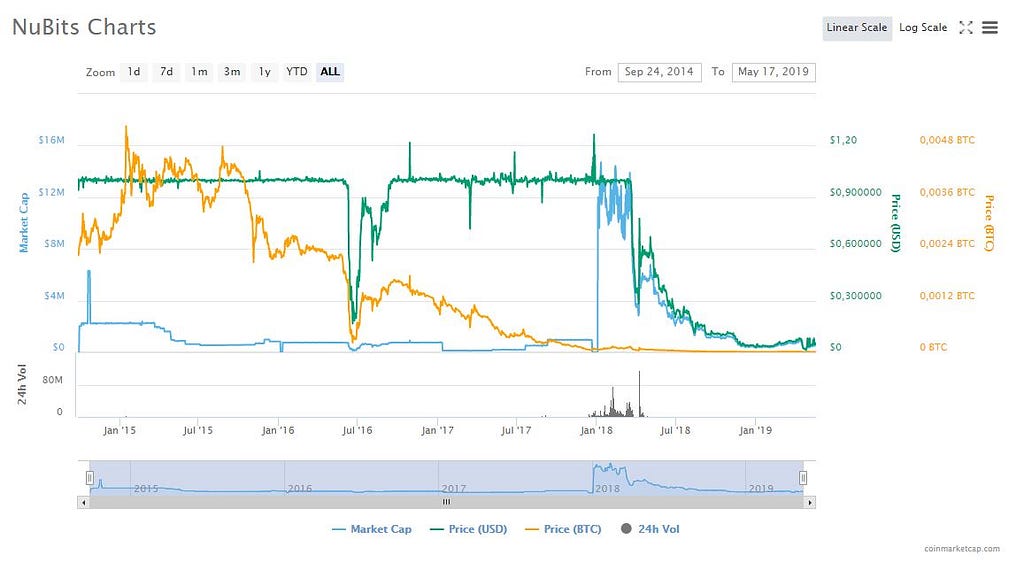Latest news about Bitcoin and all cryptocurrencies. Your daily crypto news habit.

Blockchain technology reduces the time and cost of sending money across borders avoiding banking networks. But which crypto-asset are we going to use in the next years for bill payments, shopping or taking a loan?
I already talked about what a token is, how you can develop your own economy based on this technology, but I never wrote about the problem we are issuing today: the need of a stable crypto-asset.
Central banks, big companies, even Facebook announced these days they are building their own payment crypto-asset. I will make sure you understand what this implies. In this article I will cover the next points:
- A stablecoin valuation model
- Game theory
- Designing the algorithmic stablecoin
Today’s cryptocurrencies are unsuitable for the standard financial contract that our economy relies on. If we peak Ethereum, for example, has so much volatility that doesn’t fit as a payment coin. Imagine you have a job that pays 10 Ether a month, but you still paying the monthly bills in FIAT currency. What would happen to you if the price of ETH crashed again?
Stability in the price is needed to ensure the digital transformation in any financial business.
Nowadays the merchants don’t allow cryptocurrency payment, and I think it will cost them a lot of sales in the future. Implementing this technology brings benefits like:
- Being immune to fraud
- The transaction fees can be much lower than credit/debit cards
I’m not saying to put all over the places a PundiX POS so we can pay with tokens, I’m a bit more conservative and willing to create a Standard Coin that will be exchangeable with any other digital currencies that we have today.
If you’re in a country with weak institutions and unstable currencies, high rates of inflation and currency devaluation are more common. In these markets, like Venezuela, I expect a high demand for a stable crypto-asset, as any financial contract (salaries, loans, futures and options contracts) depends on price stability.
A stablecoin valuation model
An economic model is understood as the one, when applied a series of algorithms, creates standards for the currency to be useful in the network, to bring value to the user when using it, and to build rules to protect the coin from the market volatility or the price manipulation.
To know the Network Effect of a crypto-asset, we have to focus on the value that brings to the final user. The design is built based on the Equation of Exchange, as an economic model of the transaction demand for money.
The equation is used to model currencies. You can take a look at the tremendous work that Chris Burniske and Alex Evans did.
A simple definition would be four variables which describe the relationship between purchases made in an economy and the amount of circulating currency. The parameters of the formula [M·V=P·Q] behind it, are defined like this:
- M = money supply in active circulation
- V = velocity of money
- P = price level of the currency
- Q = output level of economic activity transacted
Before evaluating it, let’s put in context how I understand a stablecoin.
A stablecoin scenario isn’t a bank issuing tokens to my wallet each time I make a new transfer in FIAT money. A coin with a stable price doesn’t mean to be pegged exactly to FIAT currency. That’s not decentralization, that’s not bringing the Blockchain value to the user, that’s just the same amount of money the user has in their bank account duplicated into his wallet.
This methodology already works in such a bunch of musical events, like Tomorrowland. Then, why a bank would want to create a new stable crypto-asset? Doesn’t make a lot of sense.
If we go back to the Equation of Exchange, the token supply increase each time there exists a new transaction, and with more transactions more demand there will be.
<velocity = total transaction volume / average network value>
How can we study and increase the velocity in this case? How can we forecast the value that a stablecoin brings?
To answer all those questions, let’s first take a look at how game theory could help us to build a new stablecoin system.
Game theory
A game theory model has at least three components:
- Players: the decision makers
- Strategies: the decision they want to take to maintain the price stable
- Payoff: outcome of the strategies
A system cannot be developed based on the morals of a person; morality is not quantifiable after all. This is where the true genius of Blockchain comes in. The Blockchain was designed in a way that it is a self-enforcing Nash Equilibrium.
The Game Theory applies to the following scenarios:
- Token design: used to predict the actions of token-holders in response to embedded incentives
- Financial market: used to predict stock market decisions
Taking both scenarios in consideration, people prices crypto-assets not based on what they think their fundamental value is, but instead on what they think everyone else thinks their value is, or the predicted average price others share on social media.
The game theory here implies when the bank will issue more tokens that are necessary, how we can prevent it from inflation.
Let’s imagine a game where the user has to vote to maintain the price stable. From a Nash equilibrium perspective, we can define the users would be distributed between different levels. The lowest one chooses that the price it maintains between 0,97 and 1,03. The next level, users, believe that all other users are Level 1, so that, they will vote for a lower spread between the coin price, let’s put it like 0,99 and 1,01. That’s a probability near to 2% more accurate to the price we will want to maintain. The next level users will have a better voting price compared with the previous ones, and so on.
This imaginary game can work fine on the Blockchain. This implementation will always maintain the coin between the inflation rate we settle down and, of course, I don’t forget about the third component of any game theory, the reward. The main goal is to incentive users to keep the price stable.
Designing the Stablecoin
Any currency has three fundamental functions: a store of value, a medium of exchange, and a unit of account.
For a crypto-asset to become a viable medium of exchange or unit of account, there is a necessity for price stability.
As per today, there already are a bunch of stablecoins as Dai or Tether, used only for trading purpose. Does any of the existing stablecoins bring value to the user? Why do we need to create a new one? Let’s take a look at NuBits:
They were called the “World’s Best Stable Digital Currencies”. I don’t trust in a centralized and controlled coin that aims to be pegged to the dollar.
What if we can create a decentralized algorithm without the need for a smart contract to issue new coins each time there is a new transfer? A stable crypto-asset that prices itself. This will implement a monetary policy quite similar to the one used by central banks.
As per ECB, the monetary policy is to maintain price stability. The ECB aims at inflation rates of below, but close to, 2% over the medium term.
For Deutsche Bundesbank achieving price stability, is a monetary target. Then, the current deviations from a specified monetary target make the monetary authority change the interest rate to avoid price changes from the target in due time.
Ideal money is the one capable of storing both near-term and long-term.
Let’s study the right part of the Equation of Exchange, the one that it’s essential for a coin to expands, the demand. Also known as coin’s market cap or how much people value the currency.
<demand = crypto-asset price * number of coins in circulation>
To regulate the price, we need to work with the demand formula. Let’s put the case that Level 1 users voted the price to be 1,02€, then:
<d = 1,02€ * nºcoins>
When demands stay stable, we have to calculate the desired number of coins in circulation, aka the inflation rate.
<d = 1,00€ * nºcoins>
//Requiered nºcoins to maintain the price stable <nºcoins' = 1,02 * nºcoins>
It means we will have inflation equal to 2%.
Either case, when the demand will increase or decrease, because of the lack of trust in the coin, we will have 2% inflation or deflation respectively.
Final thoughts
An Algorithmic Standard Stablecoin interchangeable with Bitcoin, Ether or any of the actual cryptocurrencies will bring us the payment method that we need. Designing a stablecoin pegged to a FIAT currency is not the solution to a decentralized model.
From a Central Bank perspective, there could be separate coins for each country economy, with each stabilizing against an HICP. In case there is a problem between two big companies that maintain 15% of the economy in that country, that cannot affect the global economy; it will just affect the regional currency.
We don’t have to reinvent the wheel, the economy could benefit from the blockchain technology providing the accountability and transparency of a codified monetary policy.
Do we want to create a crypto-asset just for our own benefit, or are we going to create a new sustainable economy? Let’s build something smart.
An economic model for stable crypto-assets was originally published in Hacker Noon on Medium, where people are continuing the conversation by highlighting and responding to this story.
Disclaimer
The views and opinions expressed in this article are solely those of the authors and do not reflect the views of Bitcoin Insider. Every investment and trading move involves risk - this is especially true for cryptocurrencies given their volatility. We strongly advise our readers to conduct their own research when making a decision.

